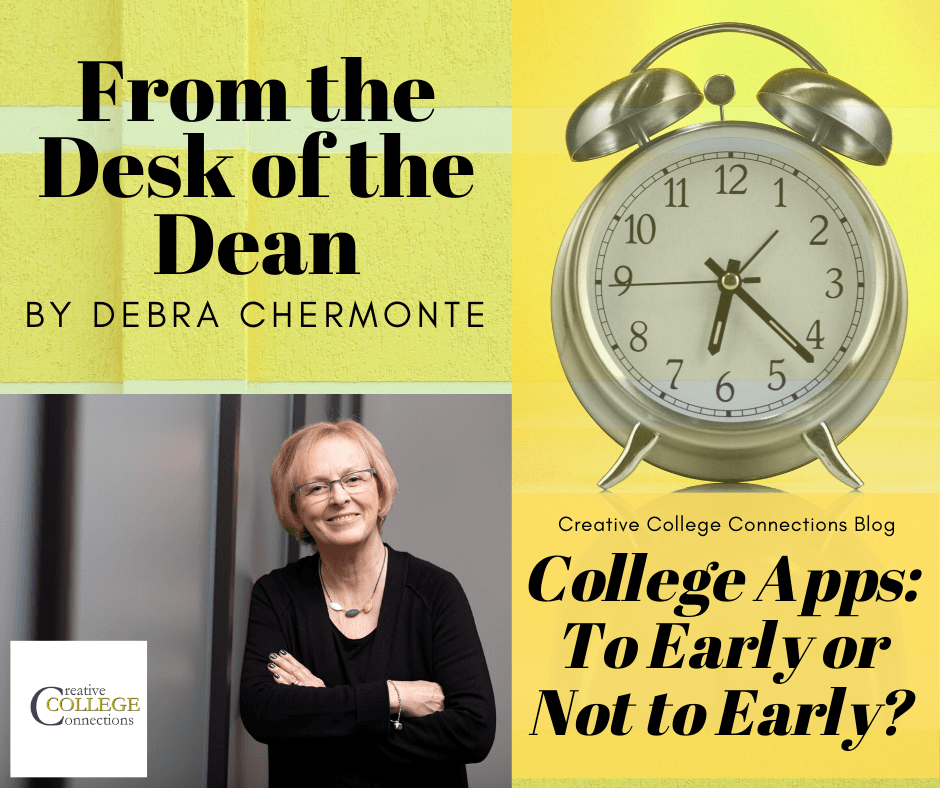College Apps: To Early or Not To Early?
How do I know if Early Decision or Early Action are right for me?
In our educational consulting practice one of the common questions at this time of the year centers on the difference between early decision and early action application plans related to college admissions.
In the late 1950’s a group of small New England colleges initiated the first binding early decision plans as a way to enroll top students before they applied to Harvard, Yale and Princeton. A lot has happened since then!
Students - early decision and early action plans can be beneficial to you...but only after thoroughly examining your college choices before deciding that you have your heart set on one institution that fits you best. As educational consultants, we have met many students who begin their college search by stating that they don’t know which college they want to attend, but they know they need to apply early somewhere. On behalf of college counselors everywhere, let me assure you that this is not a wise approach to finding your right-fit college!
Early Decision plans are binding which means that if you are accepted as an early decision applicant you must attend that college. Typically, a student who applies early receives one of three outcomes. The first, and of course the most desired, is to receive an offer of admission. In contrast, a disappointing denial letter allows ample time to submit other applications. Finally, some students are deferred to be reconsidered later in the regular decision pool, or in some cases, the second round of early decision. In this case, students should plan to submit additional grades and possibly other materials as they wait for the final outcome along with those who applied as regular decision candidates.
Early action plans are non-binding . Applicants receive early notification of their decision and are not required not to commit to the college until the universal May 1st candidate’s reply date.
About 450 colleges have early decision or early action plans and some have both. Several colleges, such as Yale and Stanford, offer a non-binding option called Single-Choice or Restrictive Early Action, under which applicants cannot apply early decision or early action to any other college although admitted students have until May 1st to make a final decision and compare financial aid awards.
It is important to remember that counselors and college admission professionals believe strongly in the ethics of applying early decision and are guided by national professional policies and practices. Be aware that many colleges with binding early decision plans require the applicant - and often a parent and counselor - to sign an early decision agreement that clearly lays out the binding nature of the plan.
Generally speaking, all early decision plans share the following attributes:
- The student applies early (usually in October/November) to their first-choice college.
- By December of the senior year the applicant receives a response from the college (although some colleges have two rounds of early decision; one plan with a deadline ranging from October to November, and another usually with a deadline in early January).
- Although a student may apply to other colleges as a regular decision applicant, only one early decision application is allowed.
- If admitted, the student must withdraw all other college applications in keeping with the binding nature of early decision.
- And finally, a non-refundable deposit is generally due shortly after admission is offered, well before May 1st.
In contrast, early action plans share the following features:
- The student applies early and receives a decision generally by the middle of the senior year.
- Unlike early decision, the student does not have to commit immediately to an early action college.
- Students are free to apply as a regular decision candidate to other colleges and universities.
- Finally, the student must select their college home no later than May 1st (the universal response date).
Students and parents often wonder who should apply early and how to determine if this is a good option. Applying early decision or early action is best done if the student can answer “yes” to all of the following:
- You have thoroughly researched a number of college options.
- If you have the academic credentials including a strong college prep curriculum, grade point average, SAT/ACT scores and class rank (if your school ranks) to meet or exceed the college’s profile.
- Have found a college that matches your academic interests and fits your social aspirations for a campus community beyond any other college you have considered.
- You are ready to make the financial commitment required to attend the college without considering other financial aid awards.
Applying early decision or early action may not be ideal if you:
- Have not extensively researched and visited colleges.
- Have decided to apply early because you feel pressured by your peers who have selected a first-choice college.
- Need to compare financial aid packages.
- You are not fully committed to attending the college.
- Need to improve your grades or standardized test scores during the first semester of the senior year to be competitive.
- Or, you are inclined to apply early to avoid stress and additional paperwork that comes with filing multiple applications.
Students often wonder if applying early will increase their chances of acceptance because they are competing with fewer applicants. This is not always true. Both the proportion and the percentage of the class colleges admit early will vary from year to year. It is certainly a fair question to ask any admissions office if there is a difference at their institution between the admit rate of early and regular decision applicants as you compare your academic profile to the college’s statistics.
Like many aspects of the college admission process, the question about which application deadline to target, is best made with calm consideration, rather than under pressured haste. Thankfully, I imagine many of you have the support and guidance of knowledgeable and dedicated school counselors and teachers close at hand. However, if you are unsure about where to turn for help I hope you will reach out to me. Click here to schedule a free 20-minute Discovery Call with me, https://www.creativecollegeconnections.com/preliminary-conversation.
By Debra Chermonte
Debra Chermonte is a national expert in the field of college admissions and counseling with over three decades of experience. Most recently, she led Oberlin College as Vice President and Dean of Admissions and Financial Aid for twenty-eight years.






